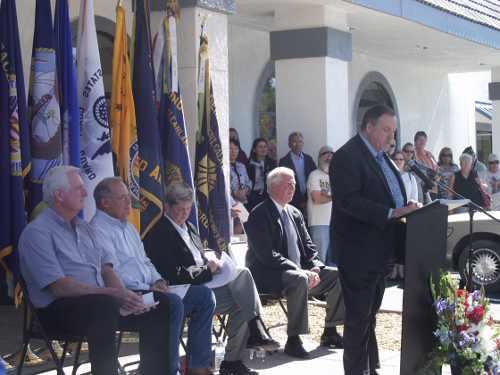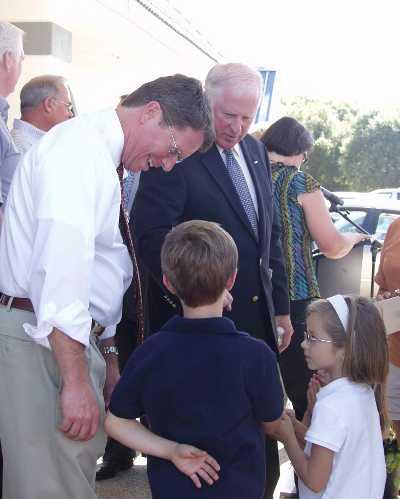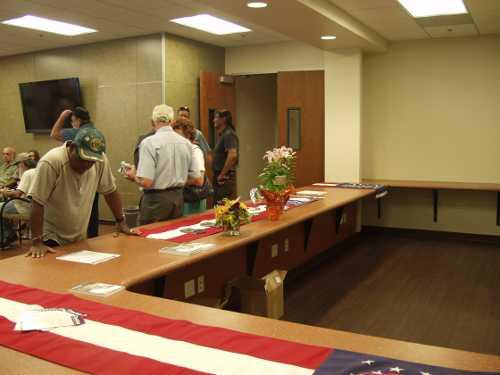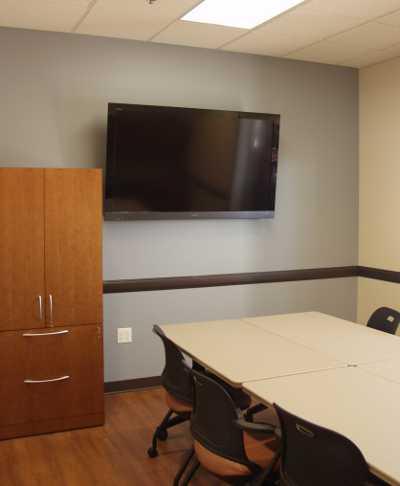MIDDLETOWN, Calif. – State transportation officials got an unequivocal message from south county residents at a Tuesday meeting: Two area road projects simply aren't acceptable.
District 1 Supervisor Jim Comstock organized the two-hour meeting, which was attended by several officials from Caltrans, including District 1 Director Charlie Fielder and his staff who came down from Eureka to meet with residents to discuss two rubberized chip seal projects.
The projects, completed at a total cost of about $2.1 million by International Surfacing Systems of West Sacramento, stretch along 12 miles of Highway 29 from the Lake/Napa County lines to the Coyote Creek Bridge and 8.5 miles on Highway 175 from Cobb to Middletown. The projects used a larger, half-inch aggregate that officials said was recently approved for use.
Mark Suchanek, Caltrans deputy director for District 1, told the audience at one point that the road projects were completed with “the best of intentions.”
In turn, the group of about 70 area residents went on to share what to them were hellish consequences of the paving projects, from vehicles with thousands of dollars of damage due to flying rocks, to a road surface they insisted is dangerous and pulls vehicles toward the center lane, along with absent striping, uneven surfaces and loud road noise that affects not just drivers but residents of homes near the highway.
One woman summed it up by telling Caltrans that the roads were ugly, bad and noisy.
For an area that relies on tourism, the roads look and feel bad and are likely to discourage visitors, residents told Caltrans.
It grew heated enough at some points that Middletown Area Town Hall Chairman Joe Sullivan said he would shut down the questions if people couldn't calm down.
The concerns about the roads were such that in the audience were several local and state government officials, including Lake County Public Works Director Brent Siemer, Pollution Control Officer Doug Gearhart, CHP Area Commander Lt. Mark Loveless, Dave Miinch of South Lake County Fire and Ruth Valenzuela, district representative for Assemblyman Wes Chesbro.
At the meeting's start, Comstock told the group, “This is about our community.”
Then, true to his word, Comstock handed over to Caltrans two sets of petitions, one from Middletown residents and one from Hidden Valley Lake, with 1,176 and 53 signatures, respectively.
“I hear you. I understand that you're not happy with the work that was done out there,” said Fielder, who had toured the local chip seal projects with Comstock in the weeks leading up to the meeting.
Fielder said the work was not what he expected, calling the large aggregate chip seal an “aggressive type of treatment” seen more often in mountainous areas for its traction.
During the course of the meeting the south county residents in attendance bristled when Fielder and his staff stated that the chip seal was a good product that met state specifications, and there was louder grumbling when state officials guaranteed that the roads were safe.
Fielder emphasized that a followup project on Highway 29 and Highway 175 would take place, and it would be the same kind of smooth treatment recently completed on Highway 29 near Lakeport.
He said he and his staff went to Sacramento two weeks ago and made the case to get the funding for the followup paving project.
However, that work likely won't be done before next June or July, due to a variety of steps necessary beforehand – including engineering and design – in addition to the fact that the road construction season is nearly at an end.
It's also a “programmed” project, which Fielder said means the work must get the approval of the state's transportation commission. He said he expects a March vote, and hoped to see the time frame for starting the work moved forward to at least May.
“It takes time to develop a project, especially when you're talking a couple million dollars,” said Fielder.
Over the next hour and a half the Caltrans team fielded numerous questions from community members on nearly every aspect of the project.
Middletown resident Fletcher Thornton said he was concerned about the crosswalks. Good crosswalks had recently been done, but the project went over them, leaving only dull white marks.
Noting that drivers respond to visual slowdown signals like crosswalks, Thornton said, “Those big white crosswalks are not there.”
Suchanek said crosswalk restriping is a part of the project that hasn't yet been completed. Representatives from International Surfacing Systems of West Sacramento, said they expect to start the striping Oct. 19 and the work should be completed the following week.
There were asked about the larger aggregate, which Suchanek said is “a newer product for us” and one with which they weren't used to working.
A community member said he understood International Surfacing Systems hadn't gotten the necessary permits. Caltrans Area Construction Engineer Alan Escarda said the contractor had all the necessary construction permits, and the company's project manager, James Wilson, said they had applied for all the permits.
At Comstock's urging, Gearhart corrected those statements, saying the company had permits for their generators but not a portable chip seal plant. They were issued a notice of violation and continued to operate.
Fielder said Caltrans is responsible for making sure permits are in order.
Gearhart added that the company also had failed to get a permit for the plant site from the county Community Development Department. “That was a minor issue compared to our issue.”
Caltrans was asked who made the decision regarding the surfacing. Suchanek said Caltrans staff drives the highways and then works to come up with treatment strategies.
Another resident asked about doing something to deal with safety issues at the intersection of Highway 29 and Hartmann Road. Suchanek said the area's volumes are higher than those at the three-way stop at Highway 53 and Olympic Drive in Clearlake, so a signal wouldn't work well. Caltrans is planning a project that will including placing flashing beacons on either side of Hartmann Road.
Steve Massaro of Hidden Valley Lake said the contrast between the stretch of Highway 29 outside of Lakeport and that near Middletown is obvious to everyone, and he wanted to know the rationale behind the south county projects.
“It's unacceptable,” he said, adding, “Why was that decision made? Who made it?”
Suchanek said it was a decision made within the district leadership, and the chip seal is being used statewide. He said it's a method for stretching limited dollars further.
Michael van der Boon, another Hidden Valley Lake resident and District 1's representative on the Lake County Planning Commission, said a quarter-mile stretch of new asphalt in front of Hidden Valley Lake – which had been “smooth as glass” – was covered over by the rougher chip seal.
Responding to a comment earlier in the meeting that the road work had been done at night so they hadn't seen they were going over the nicer pavement, van der Boon asked, “Are you kidding me?” which got a laugh, even from Fielder.
Suchanek said they had covered those newer portions in an effort to make all surface areas consistent.
Judy Mirbegian of Hidden Valley Lake said the roads weren't safe at the current legal speed limit, and asked Caltrans representatives if they thought they should acknowledge that and lower the speed limit. “Our safety is your responsibility.”
After a pause, Suchanek said he would follow up on the speed limit issue, but said lowering a speed limit requires adherence to statutes and traffic laws. “You can't just arbitrarily lower it because you want people to go slower.”
She asked if speed limits correlated to road conditions. Suchanek said they are based on the free flow of traffic in good driving conditions. Caltrans can put up advisory signs, he said.
Wayne Nelson, Middletown's barber, asked Caltrans officials if one of them would go with him on a motorcycle ride over the roads. He added that if he cut hair like they did roads, he'd be out of business. Escarda agreed to go for the offered ride.
Tom and Linda Darms, who own Tom's Auto Dynamics in Middletown, insisted the road isn't safe. Linda Darms said she test drives vehicles and has noticed that cars of all kinds are thrown around on the roadway. They've also found rocks lodged in brake rotors.
“It's not right. It's serious,” she said. “We're frightened for people in our community.”
Attention in the meeting later shifted to Loveless, who had stood at the back of the room throughout the proceedings. Community members asked him about safety issues on the roads and if the CHP had recorded more crashes.
Loveless, who had anticipated such questions, said he had his staff do two analyses of the area, looking at crash statistics from 2005 through this year and also looking specifically at the August time frame for those five years. He said both evaluations showed that they were “dead on” for the statistical average.
The meeting ended at 7 p.m., with Comstock congratulating Caltrans and the contractor's representatives for being willing to come to “the belly of the beast.”
Many people stayed on afterwards to continue questioning Caltrans and International Surfacing Systems representatives and to get claim forms for vehicle damage from the contractor.
One Hidden Valley Man man showed officials a round scar on his knee he suffered from a rock hitting him while he was riding his motorcycle, which he said has now become a more dangerous proposition.
On Wednesday, after having time to consider the meeting, Massaro wasn't satisfied with the answers he got from Caltrans, noting that waiting eight to nine months to have the road fixed is “unacceptable.”
He also didn't feel Caltrans had taken responsibility for the projects' failure, noting, “not one iota of admission that a gross error in judgment had taken place was evident.”
Massaro wondered why Caltrans did not make an effort to test and refine the process using coarse 1/2-inch aggregate instead of using the Hidden Valley Lake/Middletown corridor as a test bed.
“Now we are stuck with this crude result of really very poor decision making based on an obvious lack of any critical thought,” he said. “In a word, it was stupid.”
Massaro said he'll be looking very closely at accident statistics on a monthly, not a yearly, basis as area residents wait for the millions more dollars needed “to cover up this fiasco.”
E-mail Elizabeth Larson at This email address is being protected from spambots. You need JavaScript enabled to view it. . Follow Lake County News on Twitter at http://twitter.com/LakeCoNews and on Facebook at http://www.facebook.com/pages/Lake-County-News/143156775604?ref=mf .

 How to resolve AdBlock issue?
How to resolve AdBlock issue? 











